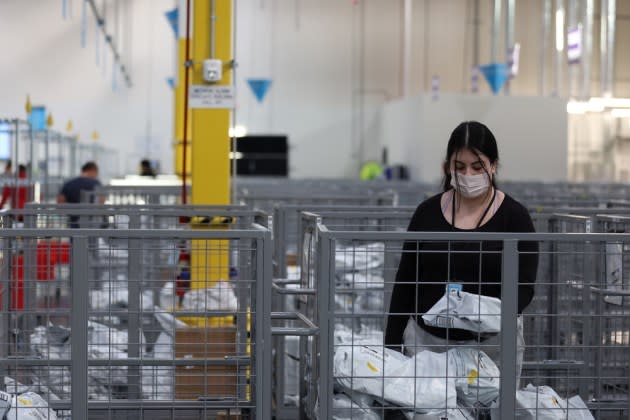Amazon’s Plastic Packaging Footprint is Shrinking. But Not in the US.

Can Amazon kick its plastic addiction? Signs aren’t promising in its largest market, according to Oceana. In a report published Thursday, the environmental nonprofit estimates that the e-tail leviathan generated 208 million pounds of padded mailers, bubblewrap and shrink film in the United States in 2022, a 9.6 percent jump from a 2021 calculation. Measured in terms of air pillows, this is enough of the stuff to circle Earth more than 200 times.
Oceana usually casts a gimlet eye on Amazon’s global plastic packaging footprint, which the Everything Store is more forthcoming about than its use at the country level, or for transactions fulfilled by third-party sellers. This year, the organization decided to focus on the United States, where Amazon derives 70 percent of its net sales, because it claims that American customers are getting iced out of plastic-free transitions taking place in other geographies. This, it noted, is despite a YouGov survey indicating that 85 percent of Amazon customers in its home market are concerned about plastic pollution.
More from Sourcing Journal
And if the Prime purveyor itself has reported an 11.6 percent reduction in the total amount of plastic packaging employed in orders shipped globally in 2022 versus 2021, that’s due to its efforts to trim its waste outside of the United States, Oceana said. In its European fulfillment network, for example, Amazon has largely supplanted single-use plastic delivery packaging with 100 percent recyclable paper and cardboard counterparts.
“Amazon’s failure to reduce plastic in the U.S. is troubling,” said Matt Littlejohn, Oceana’s senior vice president for strategic initiatives. “The company has dramatically reduced plastic delivery packaging in other major markets including India and Europe. Why are U.S. customers being left behind? It’s time for Amazon to step up and commit to a global plastic packaging reduction everywhere it operates—including in the U.S.”
Amazon, as it usually does, disputes Oceana’s numbers, which Pat Lindner, its vice president of mechatronics and sustainable packaging deemed “exaggerated and inaccurate.” He said that the online Goliath, through efforts such as lightweighting, rightsizing and the use of paper and cardboard alternatives, has managed to avoid tens of thousands of metric tons of new plastic each year in North America alone.
Beyond its sphere of influence, Amazon is expanding the availability of curbside recycling infrastructure through investments in The Recycling Partnership and the Closed Loop Infrastructure Fund. It’s also promoting innovation in materials and recycling through the Department of Energy’s BOTTLE consortium and testing new means of sortation with AI-powered robots from San Francisco firm Glacier, Linder said.
“Amazon is committed to reducing or eliminating packaging altogether, including the use of single-use plastic, and we’ve shown this by sharing consistent and transparent updates on our progress,” he said. “We’ll continue to invest, invent and scale our packaging reduction work for the good of customers and the planet.”
Oceana gives credit where it’s due, mentioning its report, for instance, Amazon’s first automated U.S. fulfillment center in Euclid, Ohio, where the Whole Foods and Zappos owner has eliminated single-use plastic delivery packaging as part of a multi-year effort to transition its domestic network to paper. The report called this a positive development with a couple of caveats: Amazon has not made specific time-bound commitments for this “multi-year effort,” nor has it specified the number of fulfillment centers that will make this change, it said.
Recycling rates in the United States are fairly dismal. Last year, the U.S. Plastics Pact, a consortium led by The Recycling Partnership, with the support of the World Wildlife Fund, found a 13.3 percent plastic packaging recycling rate among its 117 members, which include Target and Walmart but not Amazon. A significant percentage of plastic—11 percent, according to a 2020 peer-reviewed study published in the journal Science—winds up in freshwater and marine ecosystems, including rivers, lakes and oceans. By this metric, up to 22 million pounds from Amazon’s 2022 plastic packaging inventory is clogging up waterways and posing a threat to large marine animals like whales and sea turtles that often mistake filmy materials for food.
Advocacy groups such as As You Sow have filed resolutions on behalf of Amazon shareholders urging the company to outline plans to reduce its plastic packaging burden by at least one-third, something that Oceana said would be possible if its U.S. operations followed the example of its other markets. But the resolutions have so far failed to pass with a majority, though they have come close with as much as 49 percent of the vote in 2022.
But the retailer doesn’t have to wait to make bigger commitments, Oceana said. Walmart, after all, has pledged to eliminate the use of plastic mailers both at home and abroad. As of the end of fiscal year 2023, it had already removed more than 2,000 tons of plastic from circulation in the United States.
“As one of the biggest retailers on the planet, Amazon is increasingly defining how our goods are packaged,” Littlejohn said. “The company can solve its plastic problem on a global basis now and into the future if it commits to do so.”
